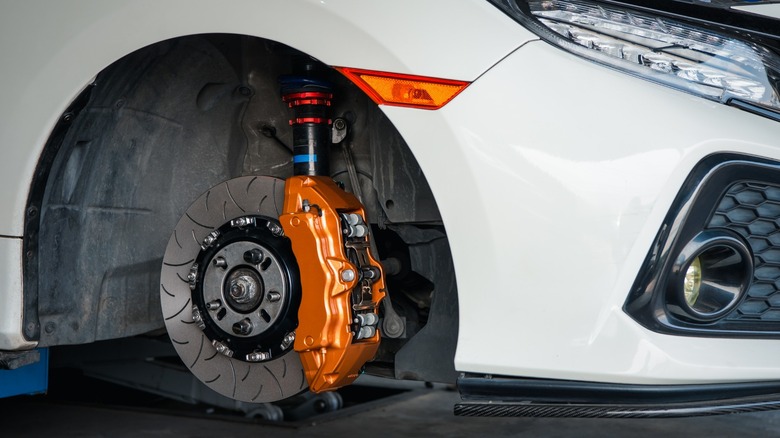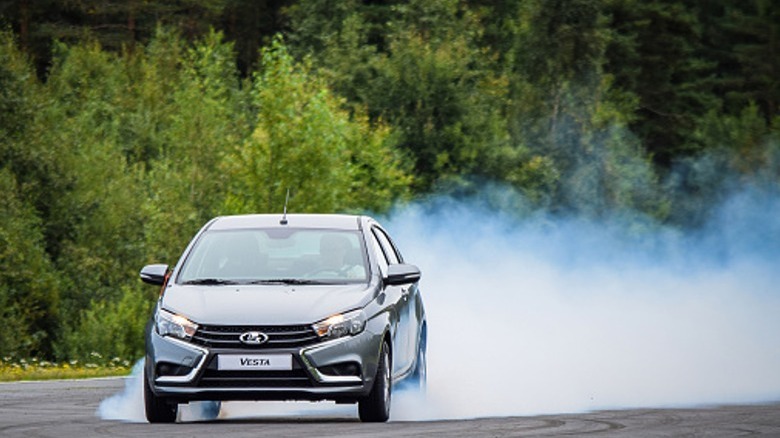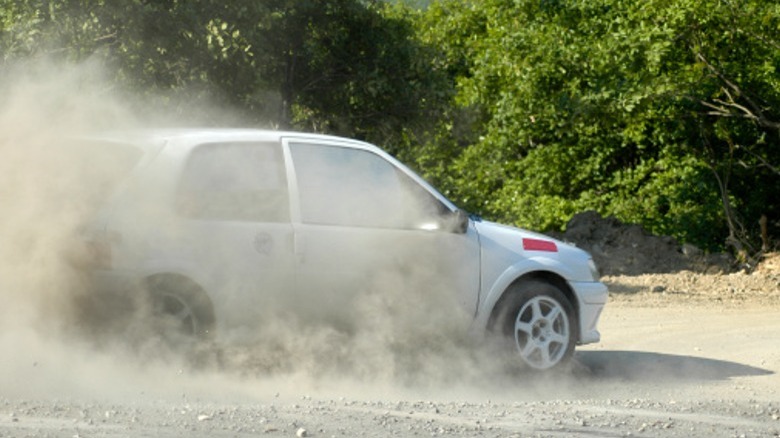Here's Why Your Front Brake Pads Are Wearing Out Faster Than The Back
If you take a second to look at your car's brakes, you might realize that the front brakes are larger than the back — sometimes they're even ventilated, and the back isn't. This isn't some kind of design fluke; it's because cars are built to give braking bias to the front. In a short summary, that's why your front brake pads are wearing out faster than the back — they're simply doing more work.
Drivers familiar with tire wear already sort of get the idea. The tires in a car wear out at different rates depending on several factors, including weight distribution and braking bias. That's why frequent tire rotation is an important part of your car's maintenance. However, unlike tires, you can't rotate brake pads because the front and back pads aren't the same size. Nonetheless, this should remind you that uneven wear among front and back wheel components is a normal part of an aging car — don't be alarmed that there's something wrong with your vehicle.
There's fundamental physics, car design ingenuity, and safety foresight at work here. But for you to appreciate all of that properly, allow us to explain the science behind this uneven braking balance.
The dynamics of weight distribution during braking
When you hit the brakes while driving, you might notice that the nose of the car dives towards the ground. It's more obvious in SUVs than sedans and sports cars, but it's something every perceptive driver feels. Everything in the car lurches forward, and a good chunk of the car's weight and inertia is thrown to the front. This weight shift demands more from the front brake pads than the rear ones.
The front brakes are designed to take on a larger share of the braking force due to this weight distribution. Since they bear the brunt of the braking load, manufacturers typically equip vehicles with larger, more robust front braking systems. This includes larger brake pads and often larger discs or rotors, which are better able to absorb and dissipate the heat generated by the friction of braking. With more work comes more wear; thus, front brake pads are prone to wear faster than the back.
The weight transfer effect is more pronounced in emergency braking situations or when navigating steep declines. In such scenarios, the front brakes work exceptionally hard to counteract the forward momentum and maintain control of the vehicle. The intense demand not only wears the brake pads down more quickly but also highlights the critical role of the front brakes in overall vehicle safety and handling. You can save your brake pads better in such scenarios by utilizing engine braking.
What happens if the back brakes are stronger than the front?
Friction doesn't improve the more tires you have stopping the car. The formula for friction is the coefficient of friction times the normal force (coefficient of friction * normal force). This formula means that surface area has nothing to do with it, so having more surface (more tires for braking), won't improve stopping power. However, the normal force in the front brake's friction improves when the car's weight shifts to the front because normal force is largely determined by weight. If most of the weight is in front, that means normal force at the rear drops due to lack of weight, and the friction there decreases. Having extra braking power, there would simply be wasted. Generally, rear car brakes provide 40% or less of the total stopping power.
When the rear brakes are stronger than the front, it can lead to handling and safety issues, especially under heavy braking conditions. Ideally, brake systems are designed so that the front brakes handle a larger share of the braking force because of the weight transfer to the front of the vehicle during deceleration. This weight transfer increases the traction of the front tires, allowing them to utilize more braking power effectively. If the rear brakes are excessively strong or apply too much force compared to the front, it can cause the rear tires to lock up before the front ones. This scenario is particularly dangerous because it can lead to a loss of vehicle stability and control, making the vehicle prone to spinning or skidding sideways.


